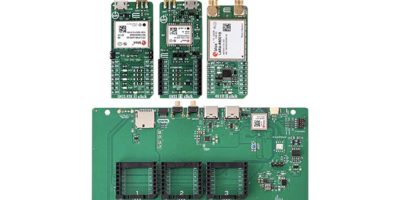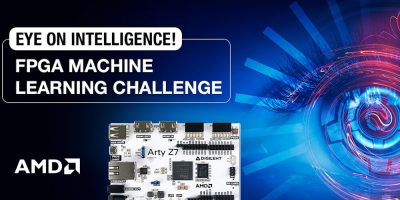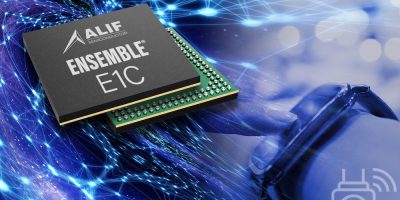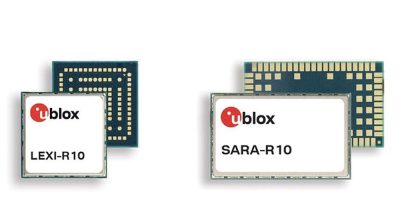Mouser is now shipping the XPLR-HPG-1 Explorer kit from u-blox. This Explorer kit is comprised of a baseboard populated with a NORA-W106 module, which integrates a powerful dual-core 32-bit microcontroller with 802.11b/g/n Wi-Fi and dual-mode Bluetooth LE 5 connectivity. The baseboard also features three mikroBUS connectors with pre-mounted click boards hosting u-blox positioning and cellular modules. The GNSS RTK 2 click board features the ZED-F9R module, a high-precision dead-reckoning. The LBAND RTK click board includes the NEO-D9S module, a satellite data receiver for the L-band correction broadcast. The 4G LTE 2 click board features the LARA-R6001D, a compact LTE Cat 1 multi-mode module offering global coverage, enabling the reception of PointPerfect correction data via mobile networks. Equipped with its GNSS and communication modules, this Explorer kit can access correction data from a satellite broadcast via L-band satellite GNSS receiver or IP connectivity using LTE or Wi-Fi. PointPerfect, the u-blox GNSS augmentation service, provides correction data delivered via the Thingstream IoT service delivery platform. The XPLR-HPG-1 also supports the Networked Transport of RTCM via Internet Protocol (NTRIP. The XPLR-HPG-1 kit’s modular design also enables users to switch out Mikroe click boards. The Explorer kit provides a flexible, modular development and prototyping platform for centimetre-level accuracy positioning applications, such as autonomous robotics, asset tracking and connected health.
Wearable
Element14 launches “Eye on Intelligence” design challenge
element14, an Avnet Community, in collaboration with AMD, has launched the “Eye on Intelligence” design challenge. This innovative competition invites participants to design and build an embedded vision project using a development kit based on the AMD Zynq-7000 SoC devices.
Embedded vision is increasingly being integrated into various projects, significantly impacting skill sets, technical innovation, and product development. AMD adaptive SoCs and FPGAs are the ideal devices for creating embedded visual intelligence systems. The challenge offers an excellent opportunity for developers to enhance their embedded vision skills by utilizing the AMD Zynq-7000 SoC-based development kit.
15 official applicants will receive a Digilent Arty Z7 (P/N 410-346-20) development platform, designed around the AMD Zynq-7000 SoC, free of charge. To compete for prizes, participants must blog about their design process and the outcome of their embedded vision project, ensuring the kit is used in the final project. The competition encourages creative use of the FPGA components and innovative applications of AMD’s adaptive SoC technology.
Example tasks for the competition include, but are not limited to, Facial Recognition Signage, ANPR Registration Plate Monitoring System, Object Classification, and Object Sorting System.
“This design challenge is a great opportunity for developers to push the boundaries of embedded vision technology using AMD’s adaptive SoCs and FPGAs,” said Andreea Teodorescu, Global Director of Product Marketing & element14 Community. “We’re excited to see the groundbreaking projects our participants will create and how they will leverage the AMD Zynq-7000 SoC to drive advancements in machine learning and AI-powered applications.”
The grand prize includes a Multicomp Pro MP720025 Digital Oscilloscope and a Multicomp Pro MP710082 Bench Power Supply, with a combined value of approximately $900. The runner-up prize consists of a Multicomp Pro MP720857 Handheld Oscilloscope and a Tenma 72-2660 Handheld DC Power Supply, valued at around $380. Lastly, the finisher prize is a Multicomp Pro MP781004 Handheld Digital Multimeter.
Applications are open now until 17 July. The 15 selected challengers will have until 25 October to complete their projects and blog entries. Winners will be announced in October 2024.
To learn more about the design challenge and enter the competition, please visit https://community.element14.com
Alif launches an MCU with AI/ML processing in a tiny footprint
Alif Semiconductor has launched the Ensemble E1C, an MCU series which combines rich digital and analog capabilities with a low-power on-chip neural processing unit (NPU) in a new compact form factor.
This new Ensemble family MCU, which combines a 160MHz Arm Cortex-M55 CPU core with Helium vector processing extension, an Arm Ethos-U55 NPU generating up to 46 GOPs, and up to 2MB of tightly coupled SRAM, is available in a tiny WLCSP package occupying a footprint of 3.9mm x 3.9mm.
The introduction of the E1C extends the Ensemble family, providing a new entry-level option for OEMs that want AI performance and ultra-low power consumption implemented in a familiar Arm environment. The new E1C also shares the same architecture as the Balletto family, allowing for software re-use across the entire family, and easy migration of applications from one device to another.
The E1C can perform both AI/ML and application control functions at ultra-low power levels. This means manufacturers can bring advanced ML capabilities to products such as wearable devices that have extreme constraints on power and space. The E1C’s capabilities are optimised for local ML workloads such as object recognition, speech recognition, sensor fusion, and adaptive audio noise cancellation, easing heavy dependence on the cloud to provide a better user experience.
The high AI performance of the E1C is matched by its power efficiency. The E1C’s aiPM technology can dynamically power only the logic and associated memory that are in use at any given time, thus achieving the lowest overall system power consumption. The aiPM power management unit implements four system-level power modes including a Stop mode which draws just 700nA.
The Ethos-U55 NPU performs 128 MACs/cycle to give ML output of 46 GOPS, and enables on-the-fly weight decompression. This results in inferencing performance some 100x faster and more power-efficient than competing MCUs based on an Arm Cortex-M4 CPU provide. The E1C’s digital cores are backed by up to 2MB of MRAM non-volatile memory alongside up to 2MB of zero wait-state SRAM. A high-speed OctalSPI interface enables expansion to external memory if required. Versions of E1C devices are offered with and without the NPU.
The E1C features a rich set of analog and connectivity peripherals. Two 12-bit SAR ADCs and a 24-bit sigma-delta ADC, a 12-bit DAC and an internal reference voltage provide for fast, precise processing of signals from external sensors. Outputs can be displayed on rich colour displays using a MIPI DSI display interface.
A broad selection of serial communications interfaces includes USB 2.0, SDIO, 2x CAN FD and I3C. Designers of connected devices can also benefit from the same low-power and high-performance characteristics of the E1C with the addition of built-in Bluetooth Low Energy connectivity by choosing the Balletto B1, launched by Alif on 9 April 2024.
Security is a core attribute of the Ensemble family, and the E1C shares the same architecture. Its advanced secure enclave, which provides a solid hardware root-of-trust enabling secure key generation and storage, secure boot, cryptographic accelerators, and certificate management, eliminates the need for an external Secure MCU in endpoint AI devices.
u-blox announces new ultra-compact LTE Cat 1bis cellular modules
u-blox has announced an expansion to its range of R10 products for the fast-growing LTE Cat 1bis cellular connectivity market. Predicted by analyst firm Techno Systems Research Co., Ltd to account for 43.6% of all non-handset cellular devices by 2029, LTE Cat 1bis is expected to be the best-selling cellular technology for the Internet of Things (IoT) for the next four to five years.
The new u-blox LEXI-R10 Global provides an ultra-compact 16 x16mm LTE Cat 1bis solution that can be used worldwide in size-constrained IoT applications such as people or pet trackers and wearables. The LEXI-R10 Global is the world’s smallest single-mode LTE Cat 1bis module with indoor location and a US MNO certified core.
Meanwhile, the new SARA-R10 series brings the same capabilities as the LEXI-R10 Global to u-blox’s popular SARA form factor. With 2G and 3G sunsets continuing globally, the SARA-R10 offers product designers using 2G and 3G u-blox SARA modules a straightforward upgrade path to 4G LTE – the most widely available global cellular standard today and for many years to come.
The LEXI-R10 and SARA-R10 offer the option to embed an eSIM, and both modules also include an integrated Wi-Fi Sniffer, providing Indoor localisation via the u-blox CellLocate service based on both a Wi-Fi and cellular networks.
One of the variants is the SARA-R10M10, the world’s smallest LTE Cat 1bis module with embedded Global Navigation Satellite System (GNSS) capable of concurrent communication and tracking. It is the ideal solution for asset tracking and telematics applications that demand continuous connectivity as well as indoor and outdoor positioning anywhere in the world, thanks to the blend of GNSS, Wi-Fi scan and global LTE coverage. This module is also 50% smaller than u-blox’s previous LTE Cat 1bis combo, the LENA-R8M10.
The new u-blox R10 modules give product designers a 4G cellular connectivity solution for IoT applications that require medium data rates, worldwide portability, ultra-low power consumption and compact sizes.
About Smart Cities
This news story is brought to you by smartcitieselectronics.com, the specialist site dedicated to delivering information about what’s new in the Smart City Electronics industry, with daily news updates, new products and industry news. To stay up-to-date, register to receive our weekly newsletters and keep yourself informed on the latest technology news and new products from around the globe. Simply click this link to register here: Smart Cities Registration







